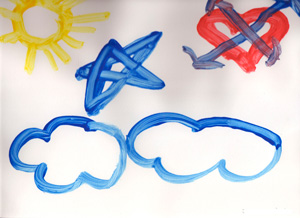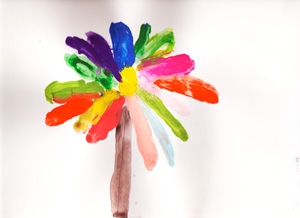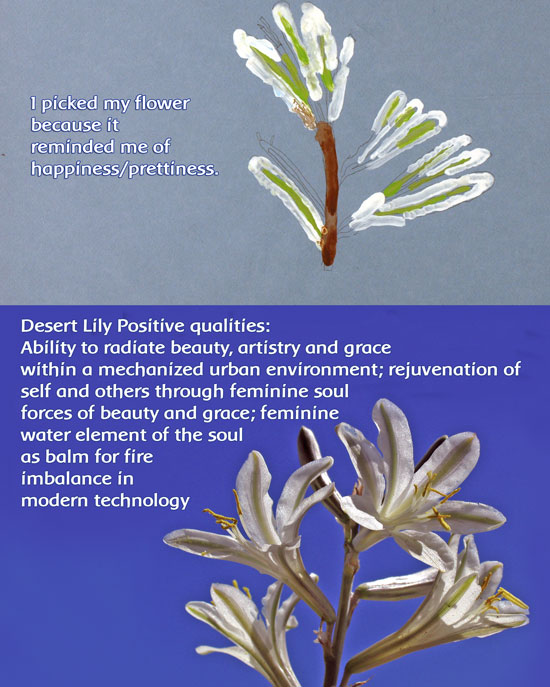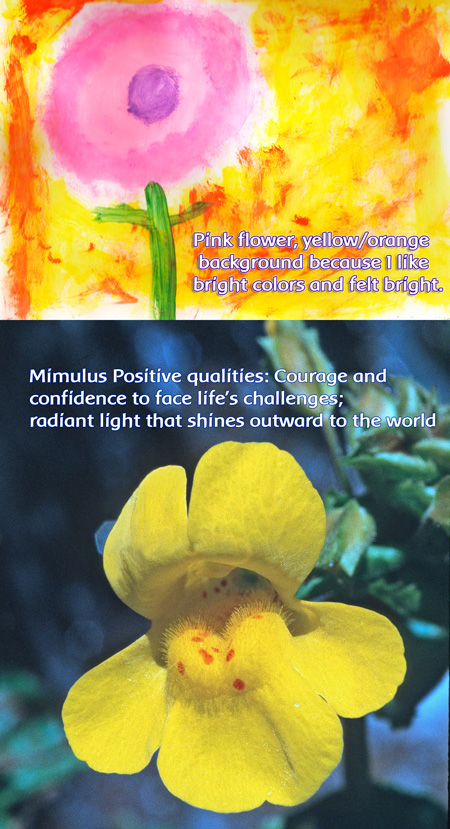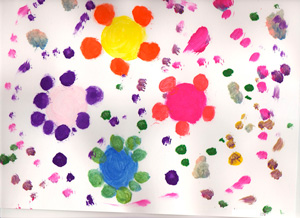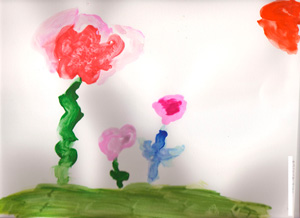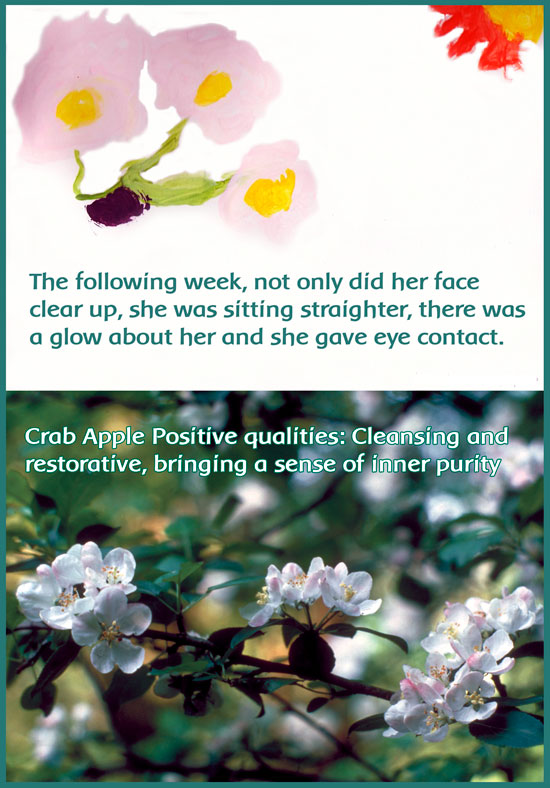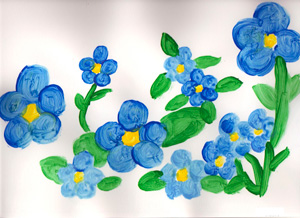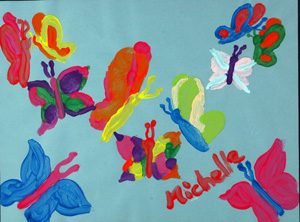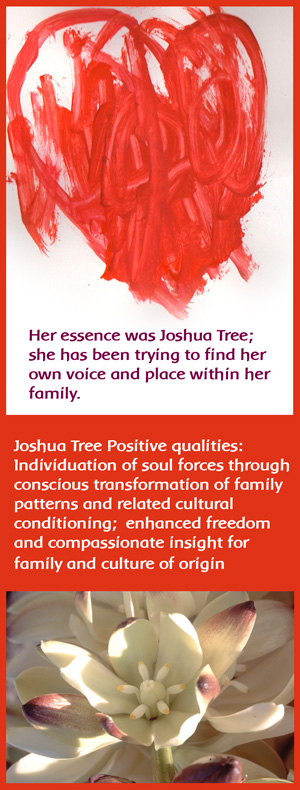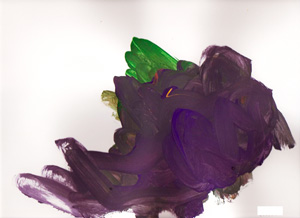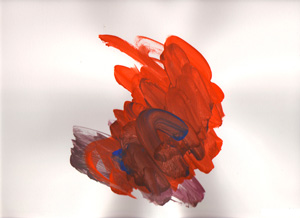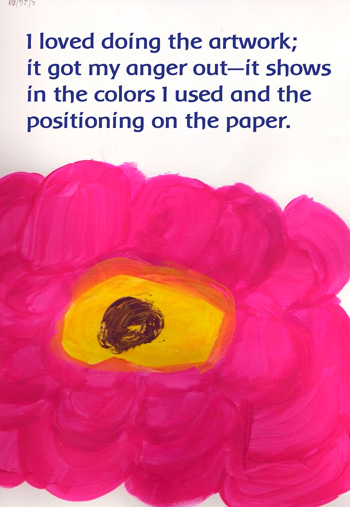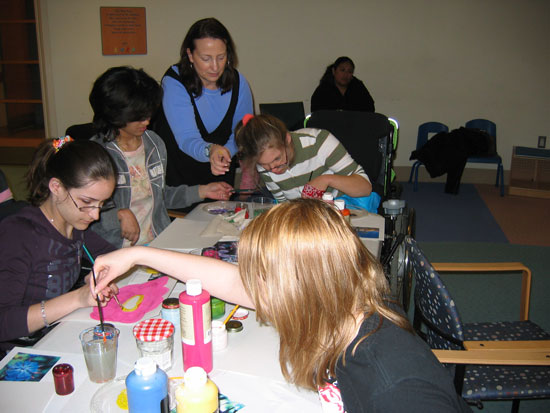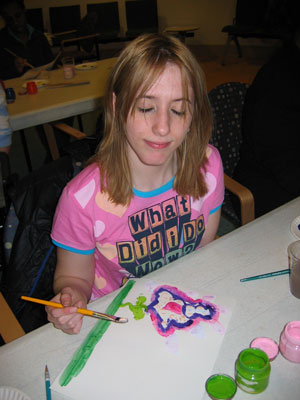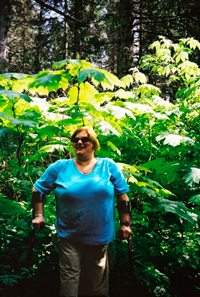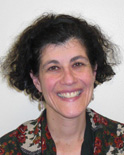|
IWD: Working to transform the lives of young women with disabilities
The materials used in the project
Flower essence selection process
How the participants selected their flowers
Initial impressions of the first session
Art work examples and interpretation IWD: Working to transform the live s of young women with disabilities The idea of developing this unique program originated several months ago and was strongly rooted in our belief that flower essences have the potential to tap into our artistic souls and greatly enhance the overall creative process. The Initiative for Women with Disabilities (IWD), a hospital-based program in New York City, created the perfect environment for this project. The Initiative for Women with Disabilities Elly and Steve Hammerman Health and Wellness Center at NYU Hospital for Joint Diseases, is a multi-disciplinary women’s center offering medical and gynecological services stressing health and wellness for women with physical disabilities. The Center is completely wheelchair accessible including the gynecology table and scale. Along with the medical services, the IWD provides an array of nutrition, fitness, health, wellness and educational programs specifically designed for women with a variety of physical disabilities, empowering them to pursue a healthy lifestyle. The IWD was established because there was a need for accessible gynecology and primary care for women with physical disabilities. All too often, women with physical disabilities neglect the basics of quality medical care due to architectural and attitudinal barriers. To fulfill this need, the IWD was established 11 years ago as the premier Center of Excellence for women with disabilities. The Center offers comprehensive medical and wellness services including Acupuncture, Reflexology, Reiki, Massage Therapy, Tai Chi, Yoga, Belly Dancing, Pilates, Self Defense, Art, and Fitness classes. This is the only center for women with physical disabilities in the New York City area that offers such a variety of comprehensive medical and wellness services. The Young Women's Program (YWP), an outgrowth of the Initiative for Women with Disabilities, introduces girls with physical disabilities between the ages of 14 to 21 to concepts of health and wellness. The program assists young women via classes and workshops to develop a better sense of themselves, as well as respect and honor their bodies. This after-school program is the only health and wellness program for girls with physical disabilities being offered in the tri-state area. The program acts as a bridge from adolescence into womanhood for girls with physical disabilities promoting a healthy lifestyle. Most importantly, the program provides young women an opportunity to socialize with their peers, develop friendships and share resources. As a result, there are positive changes in the young participants, who engage in many forms of physical activity for the first time, brave new approaches to wellness, discuss their feelings about their bodies, and begin to connect to each other as friends.
The Center is run by women for women and about women. The staff involved in this article are: Judy Goldberg, Director of the Center, who was a flower essence therapist and a Certified Counselor; Daniela Sirotti, also a flower essence therapist and the art instructor for the Young Women’s Program; and Nancy Xenakis, a licensed Clinical Social Worker and the Program Coordinator for the Young Women’s Program. The three of us collaborated in putting this program together and each of us had a specific role. Judy and Daniela designed and implemented the Flower Essence Component, and Daniela and Nancy designed the Art Component. Nancy’s role was pivotal by meeting individually with the participants after the class series to review and interpret their art work and discuss what the overall experience was like for them.
Description of the program participants and nature of their disabilities
Due to the range of physical disabilities represented, primarily Cerebral Palsy, Spina Bifida and Muscular Dystrophy, the classes are adapted to ensure that all of the young women can participate. This includes having adaptive art supplies available for easy grasp, as well as tables with ample workspace and wheelchair height. Although the program is adapted to meet its participants’ functional needs, its aim is to offer classes where the subject matter and teaching level is challenging and holds the participants’ interest.
The materials used in the project
Administration of the essence was a challenge on many levels. The classes are held in a hospital setting and the essences contain non – FDA approved ingredients so that oral administration was not possible. We also preferred to avoid oral administration as it’s a reminder of taking medication. It was decided to add the flower essence to a jar of Self-Heal Creme. The plan was to give each student the flower essence that they had selected mixed in with the Self-Heal Creme. This is a gentler way of introducing essences, and using this type of creme for the body is very feminine. We felt it is important that the young women have an opportunity to feel pretty and develop more positive relationships with their bodies. They were encouraged to use the creme for the next month—on their faces, hands and bodies—reminding them that this was “their” creme, not that of their family members or caregivers. For those who rely on assistance with bathing and dressing it was suggested that they not have their caregivers’ fingers touch the creme but use a plastic spoon so that others energies could not interfere with the energy of the essences. We asked them to report back to us how they felt physically and emotionally, how others perceived them, and if anything new developed. All the participants were very excited to receive their “flower creme” as they called it.
Flower essence selection process In order to not overwhelm the young women, we decided to select essences from the 38 English Bach and 48 Range of Light essences. We decided to select essences that where soothing, uplifting and fun, while supportive of the creative process; we wanted to encourage empowerment in the young women. The selection was done by pendulum, intuition and/or consulting a repertory. The following are the essences that were selected for the young women:
English flowers
Range of Light
flowers
How the participants selected their flowers
For example, a 19-year-old woman, H, with Cerebral Palsy who uses a power chair, lives at home with very protective parents, and who has been trying to find her own voice and “branch” within her family, selected Joshua Tree. A 15-year-old with Cerebral Palsy who is ambulatory with the use of a walker, and has a severe case of skin acne, selected Crab Apple. After the young women selected their essences, each received a jar of Self-Heal Creme with their chosen essence mixed into it.
Class #1 – Introduction and painting of flowers
Initial impressions of the first session
Art work examples and interpretation Based on the above background material and outline of this series, the following are examples of the artwork and outcomes of the young women’s experiences. In order for the young women to understand the flower they chose, while Daniela was working with them on their art projects, Judy went to each student, giving them their creme along with the picture of their flower, and explained the qualities of the flower essence. She also asked the young women what was happening in their lives so they could connect with the flower they chose. For example, one young woman, who has a rare seizure disorder and is a wheelchair user, picked Cerato. She is very dependent on her mother and will not make a decision without asking others. Judy shared this observation with her, and she gave a big smile and said, “That’s me.” Examples of the artwork are shown and described in this article. Four of the watercolors from this class series are featured on note cards that are being sold at the IWD. This has been a way to exhibit the young women’s art work, heighten public awareness of the Program, and gain proceeds for future programming. Participant J selected Desert Lily. J has a partial leg disability; she is ambulatory, very quiet and keeps to herself. Her brother is her legal guardian and her uncle takes her wherever she needs to go (both parents are not in the picture and her grandmother died a few years ago). She has very “boyish” features and dress. When she picked the flower, she continually smiled throughout the process. When Judy explained the flower to J, she asked her whether she ever feels “pretty.” She said, “No, but I would like to.” She was very serious in painting her flower. At the second class, J was more talkative than the previous week. She shared that she liked being able to just paint from her imagination rather than trying to copy from a photograph. After a few weeks using the creme, she started to dress in a more feminine manner. One week she did not attend the Program. She reported that her aunt was doing her hair that afternoon and she wasn’t able to come. We were all delighted to see her new hairstyle. She seemed lighter and engaging, though still quiet. This has carried over into the fall term as she dresses more femininely, her hair is always done and she started to wear a bit more make-up. Most importantly, her social life has improved; she is studying hard in school and plans to go to a community college. Nancy met with J a few weeks after the completion of the painting series and asked her about the flower that she painted.
She responded:
Her artwork (below, right) was selected as the YWP Logo for the brochure and is one of the four note card designs.
Class 3: “The Desert Lily flower was because I was feeling happy. I painted green/white leaves because I saw a tree or flower like this. I like painting classes; I would like to do it again.”
Participant I selected Mimulus . I has Cerebral Palsy and is ambulatory. She is a very angry young woman and full of fear. She even admitted to me that she lives in fear, which may result in her anger. Her first picture was all green and large. At the Program she generally stays to herself, and sometimes her anger comes out. She has a difficult home life.
The second week after using the creme, her paintings are bright, bold, “in your face” colors. She was very focused and her artwork radiated lightness and positive feelings. She even did two paintings. She said she had a great week.
Her remarks to Nancy after the second session really describe how she was feeling after using the creme for a week: Class 2: “Pink flower, yellow/orange background because I like bright colors and felt bright. My favorite color is yellow, that is why I picked a yellow flower. Painting of many flowers/dots shows contrasting colors, pink/red, light/dark. ”
Her painting has been the most popular and is featured in one of the four note card designs. Participant K’s selection was Crab Apple. K has Cerebral Palsy and ambulates with a walker. Her face and body had very severe acne. She is very quiet and serious, very rarely smiles or gives eye contact. She took her artwork very seriously and didn’t even let other participants interrupt her. The following week, not only did her face clear up, she was sitting straighter, there was a glow about her and she gave eye contact. When asked about her week, she said it was great, and that she was so happy that her face cleared up quite a bit. Her remarks to Nancy after the second session were:
When K returned this winter, she had let her hair grow, her face was still cleared up and she radiated confidence. She has been taking her schoolwork very seriously and plans to go to college. This painting was included as one of the four note card designs.
Participant M’s first flower selection was Twinflower. This young woman is one of our more severely disabled participants with a severe form of Muscular Dystrophy. She will probably not live very long; she uses a motorized wheelchair, a feeding tube, has no mobility in her lower extremities and limited mobility in her upper extremities. She is one of the most positive women in the Program. When Judy explained Twinflower and the “karma” connection to her, her face lit up.
The third session she picked Columbine. As Judy explained the meaning of the flower, she kept nodding. As you see, the body of a butterfly is very much like the inside of the Columbine flower and describes both her inner and outer beauty.
Unfortunately M became very ill in the fall and has been unable to return to the Program. This painting is one of the four note card designs. A few words on some other paintings and participants: H, who was previously mentioned in this article, has severe Cerebral Palsy. Her speech is affected and she uses a motorized wheelchair. She is accustomed to others helping her, and in the first workshop, she had one of the volunteers come over to her and do the painting for her. Judy stepped in and said “No, no, no. You do this yourself.” We set her up with the paper taped on the table, a long-handled paintbrush and she told us what colors she wanted to use. Her essence was Joshua Tree; she has been trying to find her own voice and place within her family. Her first independent picture was a red heart. Her second picture was an abstract with many different colors. If you look closely you will see a figure in it. All her subsequent pictures had some sort of silhouette of a figure, indicating freedom and body awareness.
By the second week, H asked for what she needed, and directed Daniela to tape the paper to the table. She was also very careful not to get paint on her clothes. She painted by herself and did not ask for any help. H found her voice; she became more animated during the group sessions. She will be graduating this June and plans to attend a college program. At her session with the Nancy she reported:
Class 1:
“This painting (of a red heart) means love. Love for my mom, dad and brother. I chose the flower (Joshua Tree) because it is colorful. The yellow at the bottom of the painting is the sand.”
Class 2: “I was happy; they (the paintings) represent me. They also represent my being proud of everything I have done like getting a new wheelchair. ”
E has Spina Bifida and uses a manual wheelchair. She is very lively and friendly. However at times, she says things that get her into trouble with her peers. When she approached the table with the pictures of flowers she got very excited and grabbed Sierra Primrose right away. This essence fit E perfectly in that she lives life as enthusiastically as she can with gratitude. However under this, there is fear and frustration. Her pictures exude liveliness.
In meeting with the Nancy, E reported the following:
Class 1:
“
I love pink, that’s why I picked a pink flower.
”
Class 2:
“
I painted a lighter shade of pink because I was feeling angry/upset. I threw pink and green together because I had time.
”
Class 3: “I used bright pink because I was feeling better. I didn’t have time to finish. I focused too much on the size of the petals, symmetry and wanted it to be perfect; the way I see it in my mind, I want it to be on paper. I’m a neat freak, I like things in place. I loved doing the artwork; it got my anger out--it shows in the colors I used and the positioning on the paper.” It took E three sessions with this flower and the art to admit and deal with her anger. By the second and third sessions, the interaction among the young women was very lively; they told personal stories, shared the day’s events, and exchanged cell phone numbers. By design, the classes appeared structure-less. The coordinators wanted to create an environment free from constraints. Minimal direction was given to the young women in order to allow them to find their own unique rhythm and balance with the colors and the brush. What has been emerging is a tapestry of colorful images, blended with laughter, sharing of personal stories, and developing friendships.
During the fitness classes that followed the art classes, everyone was very present and followed the routine well.
Conclusion
“Peaceful”
In conclusion, the outcome of this exciting project is that art combined with flower essences is allowing these young women to be more relaxed, and to be focused at the same time, but most of all to have fun! What more can one ask from an art class?
|

To install this Web App in your iPhone/iPad press ![]() and then Add to Home Screen.
and then Add to Home Screen.
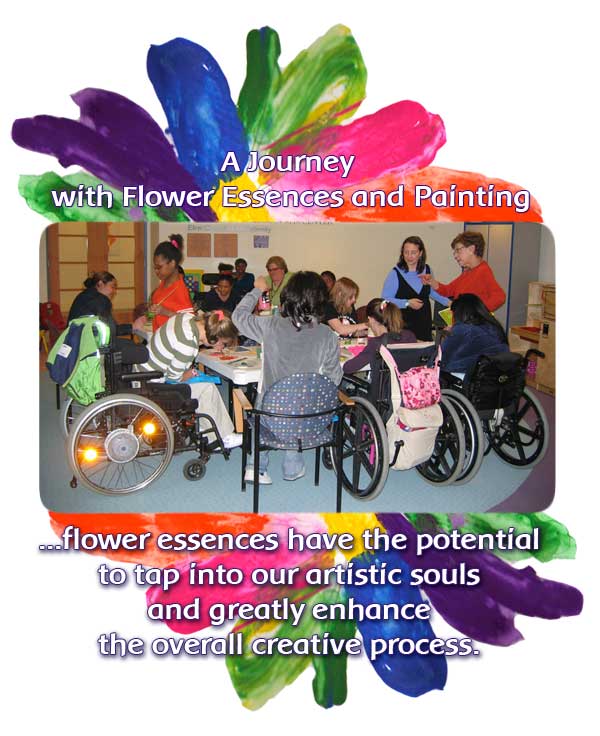
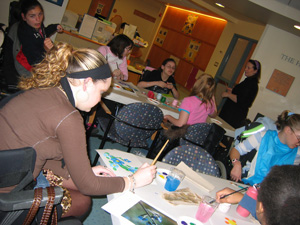
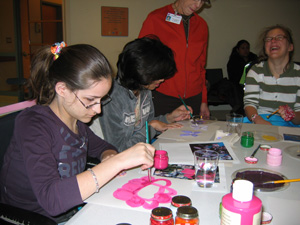
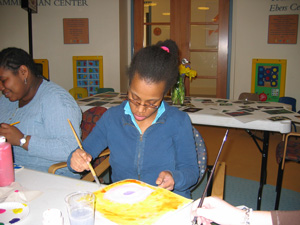 The participants in the Program are primarily high school students, 14 – 21 years of age. The majority of the participants reside within the five boroughs of New York City and the Program serves young women from diverse ethnic, racial and socioeconomic backgrounds. The nature of the young women’s physical disabilities are: Cerebral Palsy, Spina Bifida, spinal cord injury, seizure disorders, leg discrepancies (i.e. length and muscle strength of lower extremities), Muscular Dystrophy and other neurological and neuromuscular disorders. The young women use a variety of modalities for independent mobility including motorized and manual wheelchairs, walkers, canes and crutches. All participants are cognitively intact and can follow directions. The majority work independently unless they need assistance due to upper extremity disabilities such as spasticity in an upper extremity due to Cerebral Palsy.
The participants in the Program are primarily high school students, 14 – 21 years of age. The majority of the participants reside within the five boroughs of New York City and the Program serves young women from diverse ethnic, racial and socioeconomic backgrounds. The nature of the young women’s physical disabilities are: Cerebral Palsy, Spina Bifida, spinal cord injury, seizure disorders, leg discrepancies (i.e. length and muscle strength of lower extremities), Muscular Dystrophy and other neurological and neuromuscular disorders. The young women use a variety of modalities for independent mobility including motorized and manual wheelchairs, walkers, canes and crutches. All participants are cognitively intact and can follow directions. The majority work independently unless they need assistance due to upper extremity disabilities such as spasticity in an upper extremity due to Cerebral Palsy.

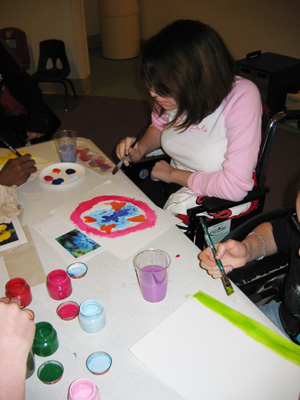
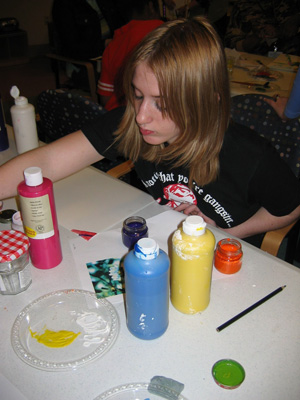 To accommodate the wide range of disabilities, we decided on water base tempera paint, long brushes and large print paper as mediums to allow for more freedom of movement and expression. Adaptive brush devices were also used to encourage each student to create their own art without any assistance from others. It is not uncommon for young people with disabilities to have over-protective parents that do too much for them, while depriving them of their independence. In some instances, the paper was taped to the table. Each student was given a set of premixed colors (several students helped with the preparation of the colors prior to the class), and their own brushes to eliminate as many physical barriers as possible and to allow for creativity to emerge.
To accommodate the wide range of disabilities, we decided on water base tempera paint, long brushes and large print paper as mediums to allow for more freedom of movement and expression. Adaptive brush devices were also used to encourage each student to create their own art without any assistance from others. It is not uncommon for young people with disabilities to have over-protective parents that do too much for them, while depriving them of their independence. In some instances, the paper was taped to the table. Each student was given a set of premixed colors (several students helped with the preparation of the colors prior to the class), and their own brushes to eliminate as many physical barriers as possible and to allow for creativity to emerge.
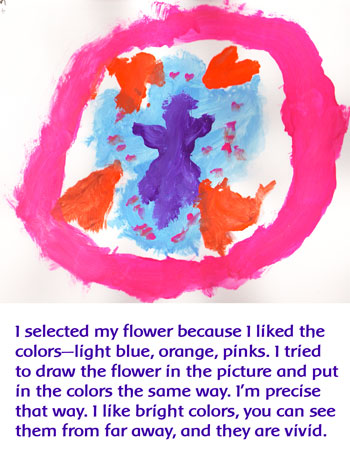 During the first class, all essences and corresponding pictures were brought into the classroom. All images had been displayed on several long tables to allow for the wheelchair users to have easy access to seeing the images. The young women were presented with the pictures of the flowers and were asked to select one. It was astonishing to see how quickly students were able to select “their flower.” There was very little or no hesitation, no uncertainty, no comparing notes with the other students. Whether it was a color or a shape that attracted each young woman to a certain selection, it was clear that each young woman intuitively knew what to select. This was also confirmed when we began looking at the selection and comparing it with their personality traits and personal histories.
During the first class, all essences and corresponding pictures were brought into the classroom. All images had been displayed on several long tables to allow for the wheelchair users to have easy access to seeing the images. The young women were presented with the pictures of the flowers and were asked to select one. It was astonishing to see how quickly students were able to select “their flower.” There was very little or no hesitation, no uncertainty, no comparing notes with the other students. Whether it was a color or a shape that attracted each young woman to a certain selection, it was clear that each young woman intuitively knew what to select. This was also confirmed when we began looking at the selection and comparing it with their personality traits and personal histories.
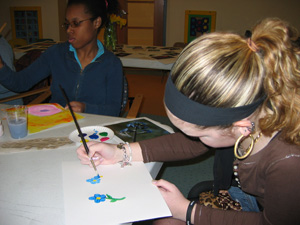 The series of three painting classes spanning over a 6-week period, was adapted from a 10-week painting course. During the first class, the structure of the series and the medium was explained, and the young women were asked to paint the flower that they had selected from the photographs. The second class encouraged the students to use their imagination by painting an imaginary flower. The last class was a study in colors and feelings, and the young women were asked to express their feelings through colors. We wanted to create an environment free of constraints.
The series of three painting classes spanning over a 6-week period, was adapted from a 10-week painting course. During the first class, the structure of the series and the medium was explained, and the young women were asked to paint the flower that they had selected from the photographs. The second class encouraged the students to use their imagination by painting an imaginary flower. The last class was a study in colors and feelings, and the young women were asked to express their feelings through colors. We wanted to create an environment free of constraints.

